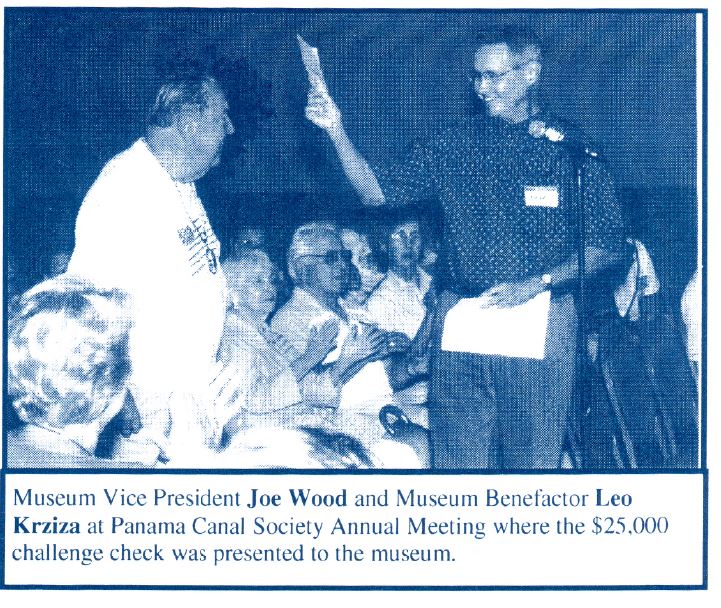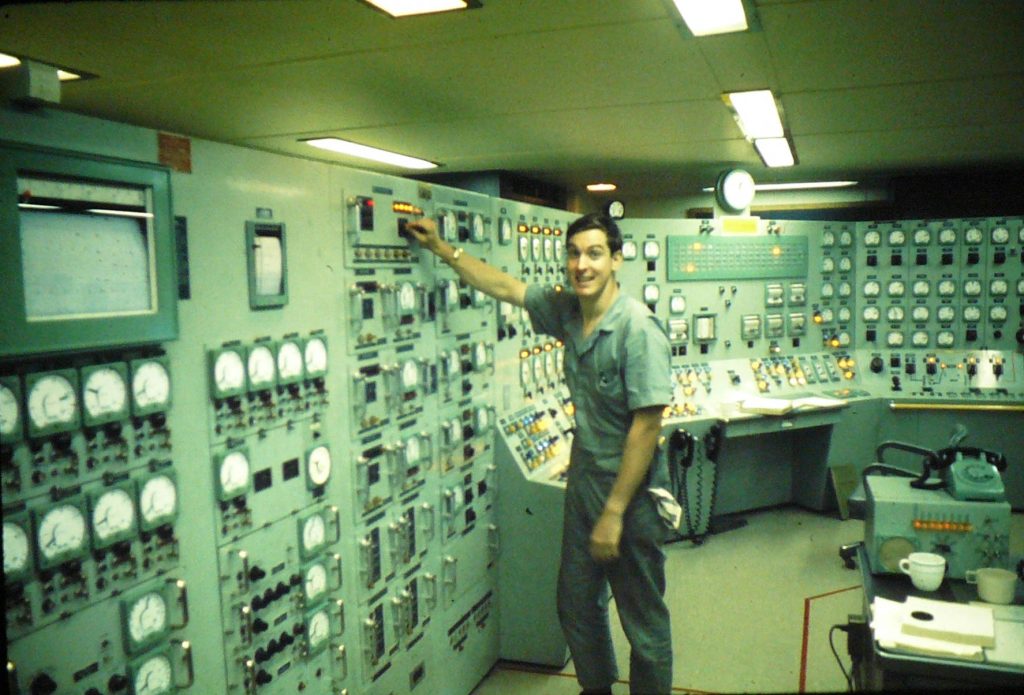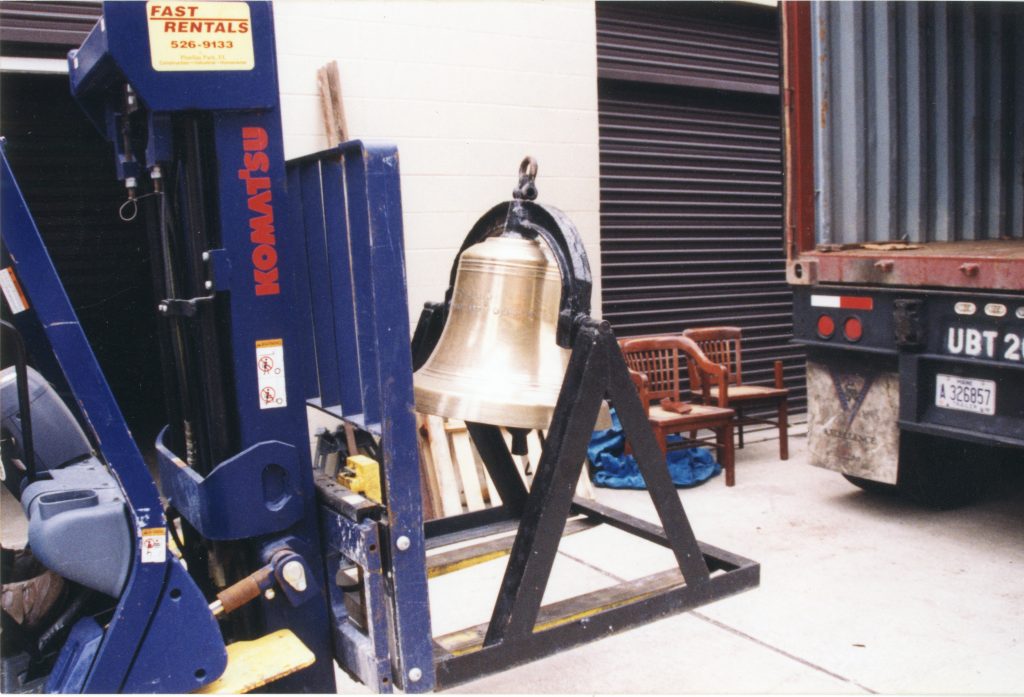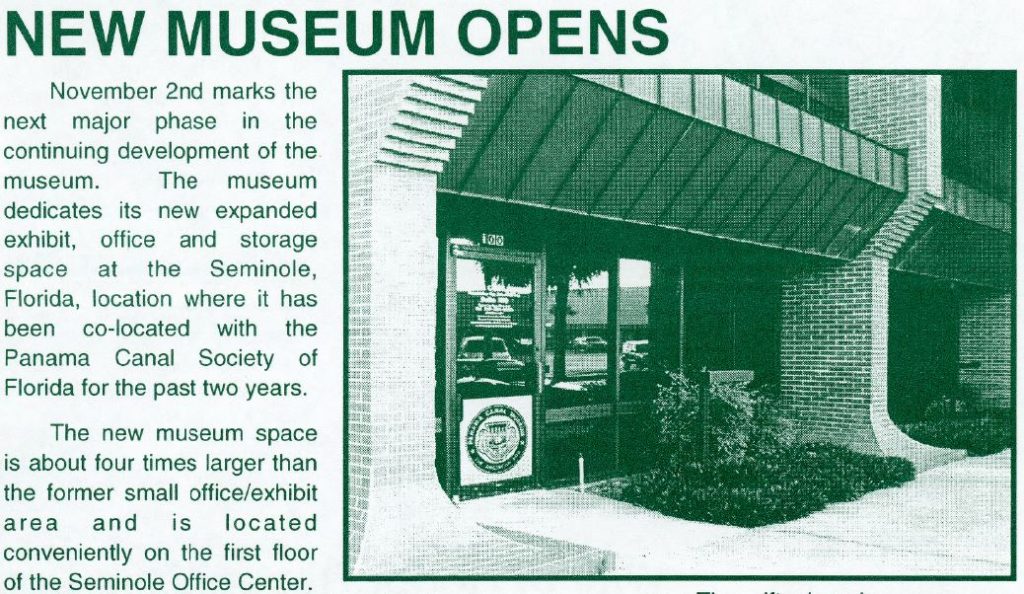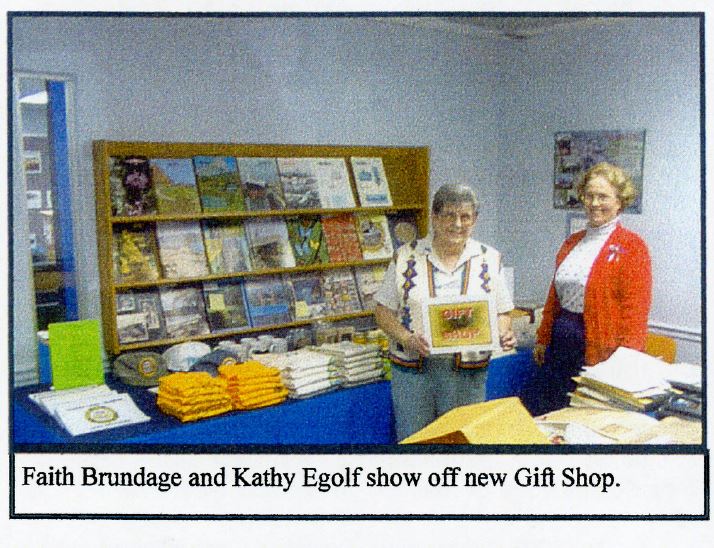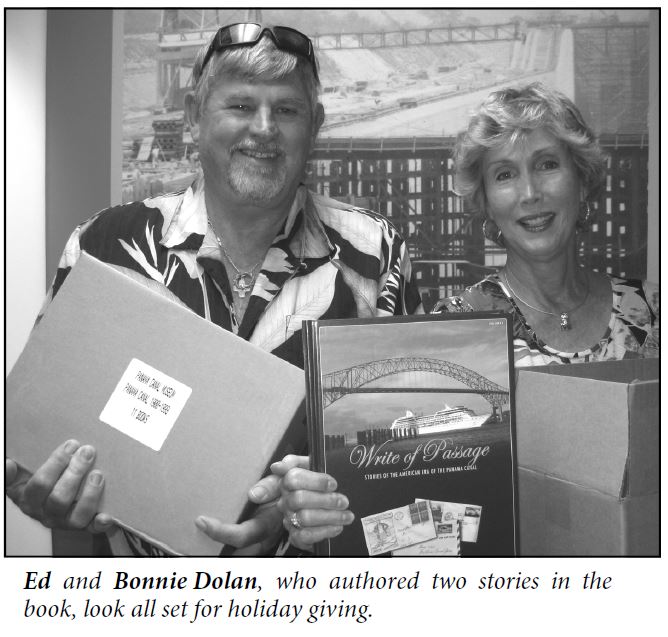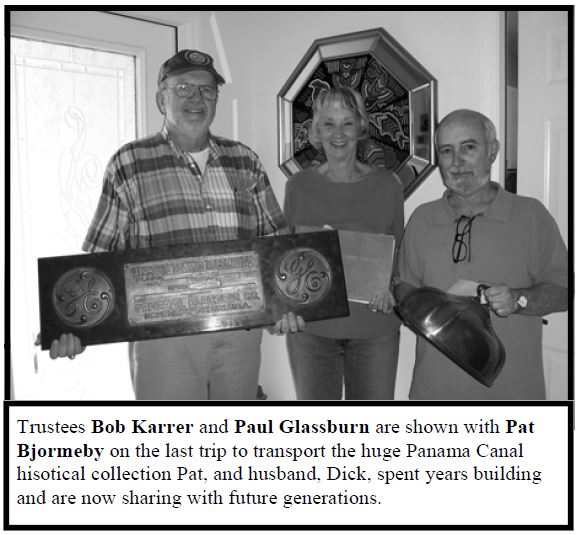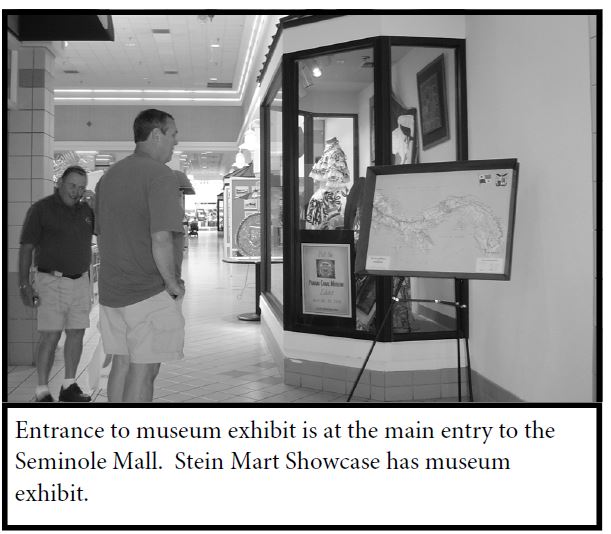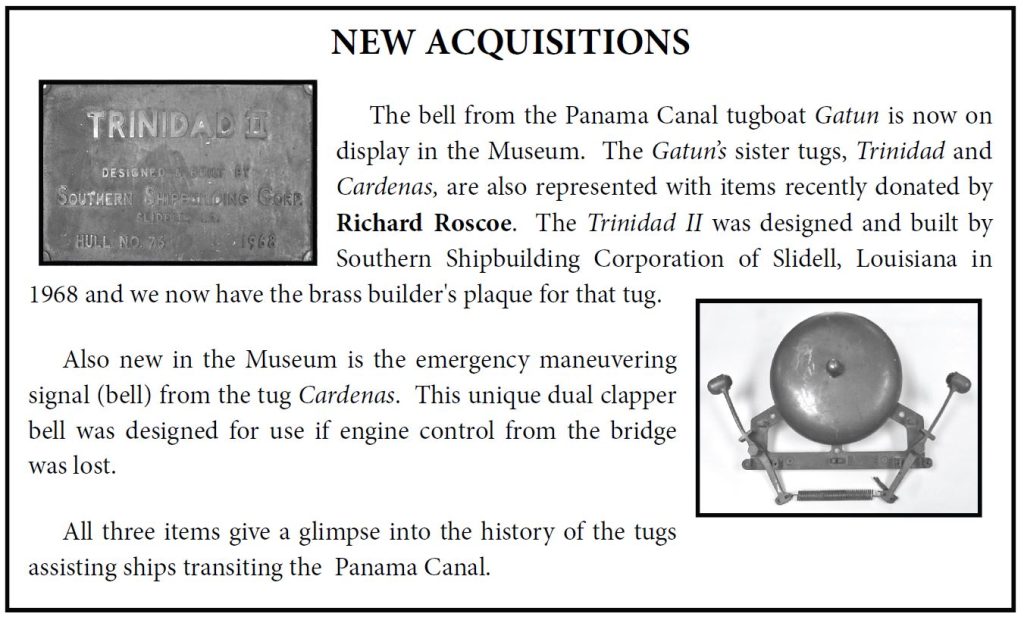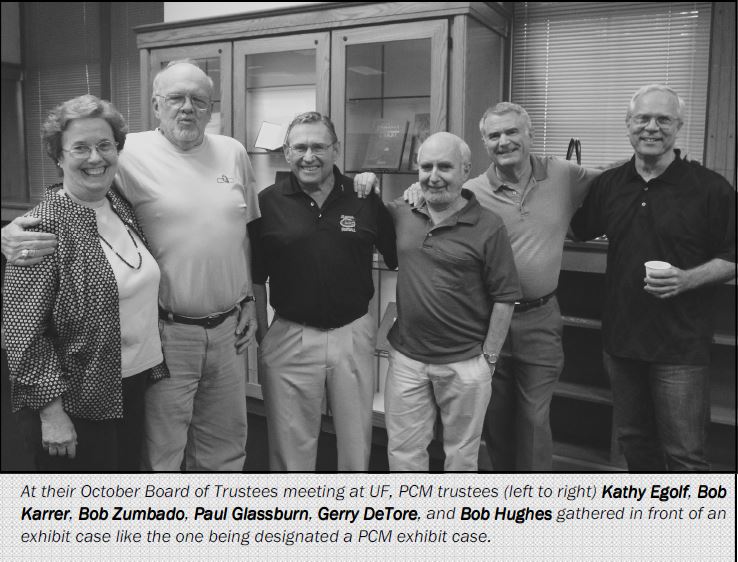-
Stuff about Sturgis

The Sturgis docked in Gatun Lake. U.S. Army Photo courtesy of Office of History, HQ, U.S. Army Corps of Engineers. Oral history interviews are a great place to learn about parts of Panama Canal history that you might not have known about or have forgotten. At this year’s Panama Canal Society reunion in Orlando, we had the pleasure of meeting and talking to Carol Hellums.
She and her husband Bill had done an interview with the Panama Canal Museum in 2011 and it opens with a great story about how they met in 1968 on an airplane headed to Panama. Bill was moving down to serve as part of the crew on the Sturgis, and Carol was visiting her parents.
Carol taught us about the MH-1A pressurized water nuclear reactor, aka the Sturgis, the first floating nuclear power station. It was built by the Army Reactors Branch of the Army Corps of Engineers as a way to generate power in remote, inaccessible, or difficult locations – the “MH” stands for mobile, high power. The Sturgis was a converted Liberty Ship, a special class of cargo ship that was built during World War II. Because the vessel would be stationary for the majority of its life it was re-designed to be a towed craft, and it was taken to its home near the Gatun Spillway in August 1968.

Sturgis in Gatun Lake. Image from the U.S. Army Corps of Engineers exhibit Army Nuclear Power Program – MH-1A Sturgis. In the early months of 1968, the Canal experienced a water shortage that affected both the operations of the Canal and the electricity supplied to the Canal Zone which was provided by the hydroelectric power station at Gatun Dam. By subsidizing the power station, the water that would have been used could instead be reserved for transiting ships.
The Sturgis generated electricity for the Canal Zone from 1968-1975, along with a second barge, the diesel-fueled Andrew J. Weber added in November 1968. It is estimated that they helped reserve over one trillion gallons of water for use in Canal operations.
Bill worked on the Sturgis monitoring the environment, taking water and sediment samples under the boat, and gathering biomass further afield in the jungles for radiological analysis. He and Carol joke that he basically got to fish in the Canal Zone for a living. Listen to a clip from their oral history below:
Transcript In the clip Bill mentions that The Big Picture, a news series produced by the U.S. Army, came down to Panama and filmed him. It took a while, but after watching a lot of episodes I finally found the one that features the Sturgis! View the episode below. The section about the Sturgis begins at 17:17:
Eventually two turbines were added to the Canal system and the Sturgis became obsolete. This story reminds us that the water shortage the Canal is experiencing today is not a new problem and that numerous efforts have been made to mitigate the issue over time. Creative solutions will undoubtedly continue be a part of the Canal’s future as it faces increasing environmental challenges.
In their interview, Bill also told an incredible story about a storm the Sturgis weathered during it’s trip back to Ft. Belvoir, Virginia to begin the deactivation of the reactor. Listen to a clip from the story:
Transcript Click through the slideshow below by pressing the arrows at the left and right sides of the image:
After the extensive process of deactivation, the ship was “mothballed” as part of the James River Reserve Fleet. Its final decontamination began in 2014 and by 2019 it had been scrapped.
To learn more about the origin, life, and decommissioning of the Sturgis view this U.S. Army Corps of Engineers exhibit: https://www.usace.army.mil/About/History/Exhibits/Nuclear-Power-Program/Sturgis/
To listen to Bill and Carol’s full interview visit out digital collection: An Interview with William and Carol Hellums
Do you remember seeing the Sturgis? Do you have any stories about the ship’s time at the Canal?
This post is part of our fall focus on the important work of the Panama Canal Museum and on the oral history program they began and which continues today. This year is the 25th anniversary of the founding of the Panama Canal Museum in 1998. The museum operated for 14 years in Seminole, Florida, before closing in July 2012 and transferring its collection to UF. The successes achieved by the museum paved the way for the PCMC to develop as a preeminent research collection for the study of the American era of the Canal. For more information on the history of the Museum, please visit go.ufl.edu/pcm
Between now and the end of December, we are celebrating their 25th Anniversary and hope to honor their hard work as well as that of our Friends of the PCMC group by adding $13,000 to the $12,000 that was raised by this year’s Silent Auction for a total of $25,000 – $25,000 for 25 amazing years!
If you would like help us reach the goal please donate here: https://pcmc.uflib.ufl.edu/oralhistory/. All funds will go to support the PCMC oral history program.
-
Twenty-Five
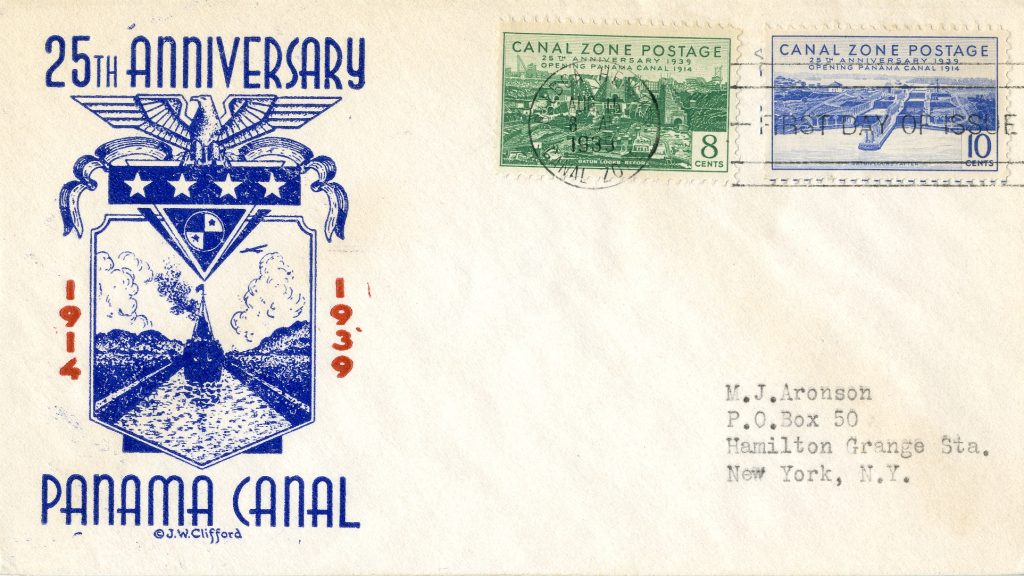
Envelope created to celebrate the 25th Anniversary of the Panama Canal, 1914-1939. Two Canal Zone stamps also created to celebrate the 25th Anniversary, Scott 126 and 127. Gift of Dr. Carl A. and Martha B. Peterson. II.2018.89.1.
Happy 25th Anniversary to the Panama Canal Museum

This year is the 25th anniversary of the founding of the Panama Canal Museum in 1998. The museum successfully operated for 14 years in Seminole, Florida, before closing in July 2012 and transferring its collection to UF. The successes achieved by the museum over those 14 years paved the way for the PCMC to develop as a preeminent research collection for the study of the American era of the Canal. For more information on the history of the Museum, please visit go.ufl.edu/pcm
Twenty-five years ago a group of individuals got together with the common goal of preserving the history of the American Era of the Panama Canal. Early on a committee was established to acquire the items needed for this “Repository of Memories”: artifacts, papers, photographs, scrapbooks, diaries, letters, yearbooks, programs, commissary memorabilia, reports, operations manuals, books, signs…you name it. Those treasures became the foundation of the Panama Canal Museum and were used to create permanent exhibits about the Spanish, French, and American Eras of the Canal, the Tivoli, and the Panama Railroad as well as 17 rotating and traveling exhibits. Under their stewardship the collection grew to over 13,000 objects.
Enjoy this slideshow highlighting PCM’s history. Press the arrows at the right and left to move through the images.
In addition to building and running the museum, they earned federal grants, had a gift shop, created educational curriculum, designed ornaments, made a board game, hosted potluck lunches (including a lunch with “Teddy Roosevelt” in 2008), ran a silent auction and created exhibits to display at the Panama Canal Society Reunion, and published three books: Opening the Gates to Canal Cuisine: Preserving the American Era in 2005, Write of Passage: Stories of the American Era of the Panama Canal in 2008, and Panama Canal Townsites in 2012. This list goes on – their work and dedication was impressive.
They even got a phone call from the popular game show “Who Wants to be a Millionaire?” with a request to answer some questions about the Panama Canal for the program! Does anyone know if they ever asked a contestant the question?
The video below offers a small glimpse into their efforts.
Although the Museum’s collection officially became part of the University of Florida in 2012, the founders and friends of the original museum have continued to steward, support, and build the collection. They are an essential part of the success of the Panama Canal Museum Collection at UF.

Panama Canal Museum Review, Spring/Summer 2011 Since the collection’s arrival at UF, it has grown to over 25,000 objects, more than 13,000 pages/items have been digitized, and our Friends have helped raise over $1.1 million to support it. In 2017, we opened the Albert H. Nahmad Panama Canal Gallery where the Panama Canal Museum’s legacy lives on through annual rotating exhibitions.
The Silent Auction that the Museum started hosting at the Panama Canal Society Reunion in 2003 has also continued and is now run by the Friends of the Panama Canal Museum Collection. The current auction committee includes some familiar faces from the Panama Canal Museum’s vendor tables, “The Walkerettes”.

The Walker sisters Mickey, Jeanne, and Carol and their aunt Emily Bliss volunteer, running the Panama Canal Museum’s vendor tables at the Panama Canal Society reunion in 2011. Read the Panama Canal Museum Review’s wonderful write up about these ladies and their families multi-generational history at the Canal on page six of the Fall/Winter 2011 issue. Between now and the end of December, we are hoping to honor their hard work by adding $13,000 to the $12,000 that the auction raised at the reunion this year for a total of $25,000 – $25,000 for 25 amazing years!
If you would like help us reach the goal please donate here: https://pcmc.uflib.ufl.edu/oralhistory/. All funds will go to support the PCMC oral history program.
Another happy anniversary to the Panama Canal Museum and a huge thank you for everything you have done to collect and preserve this history!
Back in 2003 Leo Krziza made a similar challenge – he offered to donate $25,000 to the museum if other donations could be raised to match it. The response exceeded his expectations with gifts from others totaling $44,000. Leo presented his check, written in memory of his sister Esther, to Joe Wood at the Panama Canal Society Reunion.
